|
|
|
|
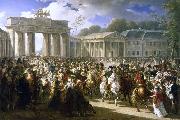 |
Charles Meynier
|
|
Charles Meynier (1763, Paris - 1832, Paris) was a French painter. A student of François-Andre Vincent, Meynier won the second prize in the 1789 prix de Rome competition. He made designs for the bas-reliefs and statues on the Arc de Triomphe du Carrousel and was, from 1816 onward, a member of the Academie des Beaux-Arts
|
|
|
|
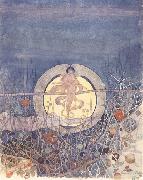 |
Charles Rennie Macintosh
|
|
Scottish Art Nouveau Designer , (1868-1928).
Scottish architect, designer and painter. In the pantheon of heroes of the Modern Movement, he has been elevated to a cult figure, such that the importance of his late 19th-century background and training in Glasgow are often overlooked. He studied during a period of great artistic activity in the city that produced the distinctive GLASGOW STYLE. As a follower of A. W. N. Pugin and John Ruskin, he believed in the superiority of Gothic over Classical architecture and by implication that moral integrity in architecture could be achieved only through revealed construction. Although Mackintosh's buildings refrain from overt classicism, they reflect its inherent discipline. His profound originality was evident by 1895, when he began the designs for the Glasgow School of Art. His decorative schemes, particularly the furniture, also formed an essential element in his buildings. During Mackintosh's lifetime his influence was chiefly felt in Austria, in the work of such painters as Gustav Klimt and such architects as Josef Hoffmann and Joseph Maria Olbrich. The revival of interest in his work was initiated by the publication of monographs by Pevsner (1950) and Howarth (1952). The Charles Rennie Mackintosh Society was formed in Glasgow in 1973; it publishes a biannual newsletter, has a reference library and organizes exhibitions. The Hunterian Art Gallery, University of Glasgow, which opened in 1981, |
|
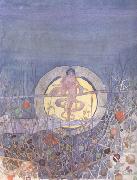 |
Charles Rennie Mackintosh
|
|
Scottish Art Nouveau Designer, 1868-1928
Scottish architect, designer and painter. In the pantheon of heroes of the Modern Movement, he has been elevated to a cult figure, such that the importance of his late 19th-century background and training in Glasgow are often overlooked. He studied during a period of great artistic activity in the city that produced the distinctive GLASGOW STYLE. As a follower of A. W. N. Pugin and John Ruskin, he believed in the superiority of Gothic over Classical architecture and by implication that moral integrity in architecture could be achieved only through revealed construction. Although Mackintosh's buildings refrain from overt classicism, they reflect its inherent discipline. His profound originality was evident by 1895, when he began the designs for the Glasgow School of Art. His decorative schemes, particularly the furniture, also formed an essential element in his buildings. During Mackintosh's lifetime his influence was chiefly felt in Austria, in the work of such painters as Gustav Klimt and such architects as Josef Hoffmann and Joseph Maria Olbrich. The revival of interest in his work was initiated by the publication of monographs by Pevsner (1950) and Howarth (1952). The Charles Rennie Mackintosh Society was formed in Glasgow in 1973; it publishes a biannual newsletter, has a reference library and organizes exhibitions. |
|
 |
Charles William Mitchell
|
|
(1854 - 1903) was an English Pre-Raphaelite painter from Newcastle. A contemporary of John William Waterhouse, his work is similar in many ways. His one famous piece was Hypatia, shown in 1885 and likely inspired by the Charles Kingsley serialized novel Hypatia or New Foes with an Old Face. This painting is currently in the Laing Art Gallery. |
|
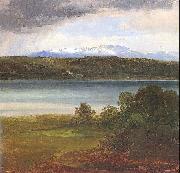 |
Christian Ernst Bernhard Morgenstern
|
|
(29 September 1805 - 12 Februar 1867) was a German landscape painter. Morgenstern is regarded as one of the pioneers in Germany of early Realism in painting. He gained this reputation in Hamburg 1826-1829 together with his contemporary Adolph Friedrich Vollmer while both were still studying; from 1830 onwards, Morgenstern, together with Friedrich Wasmann, Johan Christian Dahl and Adolph Menzel, introduced Munich to Realist painting.
Morgenstern was born in Hamburg as one of six children to a painter of miniatures, Johann Heinrich Morgenstern (1769-1813). After the early death of his father he was placed as an apprentice in the graphic workshop of the brothers Suhr. Cornelius Suhr took the young Morgenstern as his servant on a two-year journey through Germany to publicise the panorama prints which the brothers Suhr produced. 1822 followed another long journey to St. Petersburg, where they stayed for a year and to Moscow. On their return to Hamburg Morgenstern succeeded in leaving Suhr (Vollmer took his place). He became a student of the Hamburg painter Siegfried Bendixen with whom he stayed from 1824 to 1827, then continued his studies at the Royal Danish Academy of Fine Arts in Copenhagen (1827-1828) and undertook study journeys through Sweden and Norway. Bendixen introduced him to the wealthy aristocrat and supporter of the arts, Carl Friedrich von Rumohr, patron to many young Hamburg artists, on whose estate in Holstein he spent several summers. In 1830 Morgenstern went to Munich on Ruhmor's advice. He settled there permanently while undertaking extensive yearly study trips: for the first years through Bavaria, then in the summer of 1836 and in the following summers to the Alsace as guest of a patron of the arts. The winter 1839/40 he returned to Hamburg to stay with his mother. In 1841 he visited Venice and Trieste together with the landscape painter Eduard Schleich and in 1843, and again in 1846 the central Alps. In the summer of 1850 he stayed on Heligoland. |
|
 |
Christian Mali
|
|
painted Magd mit Kuhen an der Tranke am See an einem sonnigen Fruhlingsmorgen, Munchen in 1880 |
|
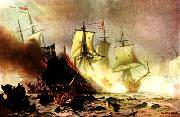 |
Christian Molsted
|
|
(1862-1930) was a Danish artist who specialized in marine painting. He is best known for his painting of the frigate Niels Juel during the Battle of Helgoland on 9 May 1864.
Born in Dragør on 15 October 1862, Mølsted was the son of fisherman Andreas Adolf Nikolaj Mølsted and Ane Hans-Nielsdatter. With financial support from a relative, he completed his school education in Copenhagen at Det tekniske Selskab where he graduated in 1879. After sailing to Madeira that summer on the frigate Jylland, he entered the Danish Academy in October 1880 with mentors such as Frederik Vermehren, Jorgen Roed, Julius Exner and Carl Bloch. During his studies, Mølsted travelled to Paris and London where he was able to observe contemporary art. He graduated from the Academy with a painting diploma in January 1885. He first exhibited in December 1884 and thereafter at the spring exhibitions. In 1889, he was awarded the Neuhausen Prize for his Skibe i Havnen ved Larsens Plads. His subjects are for the most part taken from the coasts around Copenhagen or in Jutland. Among the artist favorite subjects were the heroic battles of captains Tordenskjold and Willemoes. Historical details, as well as detailed information about the ships, was provided for the paintings by Otto Dorge, a Dragør local expert. Later in life, he also made genre paintings. Mølsted's works were widely appreciated for his perfectionist approach, his attention to historical detail and his ability to bring things to life. He died on 10 May 1930 in Dragør. |
|
|
|
|
|
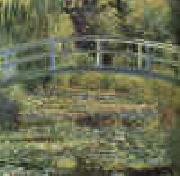 |
Claude Monet
|
|
French Impressionist Painter, 1840-1926
Claude Oscar Monet (14 November 1840 C 5 December 1926) was a founder of French impressionist painting, and the most consistent and prolific practitioner of the movement's philosophy of expressing one's perceptions before nature, especially as applied to plein-air landscape painting. The term Impressionism is derived from the title of his painting.
Claude Monet was born on 14 November 1840 on the fifth floor of 45 rue Laffitte, in the ninth arrondissement of Paris . He was the second son of Claude-Adolphe and Louise-Justine Aubree Monet, both of them second-generation Parisians. On 20 May 1841, he was baptised into the local church parish, Notre-Dame-de-Lorette as Oscar-Claude. In 1845, his family moved to Le Havre in Normandy. His father wanted him to go into the family grocery store business, but Claude Monet wanted to become an artist. His mother was a singer.
On the first of April 1851, Monet entered the Le Havre secondary school of the arts. He first became known locally for his charcoal caricatures, which he would sell for ten to twenty francs. Monet also undertook his first drawing lessons from Jacques-François Ochard, a former student of Jacques-Louis David. On the beaches of Normandy in about 1856/1857 he met fellow artist Eugene Boudin who became his mentor and taught him to use oil paints. Boudin taught Monet "en plein air" (outdoor) techniques for painting.
On 28 January 1857 his mother died. He was 16 years old when he left school, and went to live with his widowed childless aunt, Marie-Jeanne Lecadre.
After several difficult months following the death of Camille on 5 September 1879, a grief-stricken Monet (resolving never to be mired in poverty again) began in earnest to create some of his best paintings of the 19th century. During the early 1880s Monet painted several groups of landscapes and seascapes in what he considered to be campaigns to document the French countryside. His extensive campaigns evolved into his series' paintings.
Camille Monet had become ill with tuberculosis in 1876. Pregnant with her second child she gave birth to Michel Monet in March 1878. In 1878 the Monets temporarily moved into the home of Ernest Hosched, (1837-1891), a wealthy department store owner and patron of the arts. Both families then shared a house in Vetheuil during the summer. After her husband (Ernest Hoschede) became bankrupt, and left in 1878 for Belgium, in September 1879, and while Monet continued to live in the house in Vetheuil; Alice Hosched helped Monet to raise his two sons, Jean and Michel, by taking them to Paris to live alongside her own six children. They were Blanche, Germaine, Suzanne, Marthe, Jean-Pierre, and Jacques. In the spring of 1880 Alice Hosched and all the children left Paris and rejoined Monet still living in the house in Vetheuil. In 1881 all of them moved to Poissy which Monet hated. From the doorway of the little train between Vernon and Gasny he discovered Giverny. In April 1883 they moved to Vernon, then to a house in Giverny, Eure, in Upper Normandy, where he planted a large garden where he painted for much of the rest of his life. Following the death of her estranged husband, Alice Hosched married Claude Monet in 1892.
|
|
 |
claudio monteverdi
|
|
Period: Baroque (1600-1749)
Country: Italy
Born: May 15, 1567 in Cremona, Italy
Died: November 29, 1643 in Venice, Italy
Genres: Ballet, Choral Music, Miscellaneous Music, Opera, Vocal Music
|
|
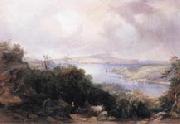 |
Conrad Martens
|
|
England/Australia Painter , 1801-1878
Australian painter, lithographer and librarian of English birth. Son of a London merchant, he studied c. 1816 under Copley Fielding. His training was as a watercolourist and his most important works are watercolours, although he also produced paintings in oils. His early work displays the taste then current for the Picturesque. Francis Danby, David Cox and Turner were artists he admired. Martens left for India in 1832 or 1833 but at Montevideo joined Charles Darwin's expedition, replacing Augustus Earle as topographical draughtsman aboard the Beagle. The work strengthened his observation of detail and skill as a draughtsman. He left the expedition in October 1834 and, travelling via Tahiti and New Zealand, arrived in Sydney in April 1835. There he worked as a professional artist, in the 1840s and 1850s producing lithographic views of the Sydney area to augment his income. In 1863 he was appointed Parliamentary Librarian, which secured his finances. The skills he had acquired aboard the Beagle helped to gain him commissions to depict the estates around Sydney. However, his admiration for Turner, and with this the desire to elevate landscape as a subject, prompted him to subordinate line to mood in a Romantic treatment of the landscape. His thoughts were clearly stated in a lecture on landscape painting given in 1856 at the Australian Library, Sydney (see Smith, 1975). |
|
|
|
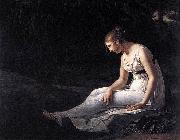 |
Constance Marie Charpentier
|
|
(born 1767 Paris, France - August 3, 1849 France) was a French painter. She specialized in sentimental genre scenes and portraits, mainly children and women. She was also known as Constance Marie Bondelu.
She studied under Jacques-Louis David and Francois Gerard. In 1788 she received a 'Prix d'Encouragement.' From 1795 to 1819 she exhibited at the Salon where she received a gold medal. |
|
 |
Constance Mayer
|
|
Marie-Françoise-Constance Mayer-Lamartiniere
French Neoclassical Painter, 1775-1821 |
|
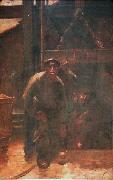 |
Constantin Meunier
|
|
(12 April 1831 - 4 April 1905), Belgian painter and sculptor, was born in Etterbeek, Brussels.
His first exhibit was a plaster sketch, "The Garland," shown at the Brussels Salon in 1851. Soon afterwards, on the advice of the painter Charles de Groux, he abandoned the chisel for the brush. His first important painting, "The Salle St Roch" (1857), was followed by a series of paintings including "A Trappist Funeral" (1860), "Trappists Ploughing" (1863), in collaboration with Alfred Verwee, "Divine Service at the Monastery of La Trappe" (1871) and episodes of the German Peasants' War (1878). About 1880 he was commissioned to illustrate those parts of Camille Lemonnier's description of Belgium in Le Tour du monde which referred to miners and factory-workers, and produced "In the Factory," "Smithery at Cockerill's," "Melting Steel at the Factory at Seraing" (1882), "Returning from the Pit," and "The Broken Crucible" (1884).
In 1882 he was employed by the government to copy Pedro de Campaña's "Descent from the Cross" at Seville, and in Spain he painted such characteristic pictures as "The Cafe Concert," "Procession on Good Friday," and "The Tobacco Factory at Seville" (Brussels Gallery). On his return to Belgium he was appointed professor at the Louvain Academy of Fine Arts.
In 1885 he returned to statuary and produced " The Puddler," "The Hammerer" (1886), "Firedamp" (1889, Brussels Gallery), "Ecce Homo" (1891), "The Old Mine-Horse" (1891), "The Mower" (1892), "The Glebe" (1892), the monument to Father Damien at Louvain (1893), "Puddler at the Furnace" (1893), the scheme of decoration for the Botanical Garden of Brussels in collaboration with the sculptor Charles van der Stappen (1893), "The Horse at the Pond," in the square in the north-east quarter of Brussels, and two unfinished works, the "Monument to Labour" and the Zola monument, in collaboration with the French sculptor Alexandre Charpentier.
The "Monument to Labour," which was acquired by the State for the Brussels Gallery, comprises four stone bas-reliefs, "Industry," "The Mine," "Harvest," and the "Harbour"; four bronze statues, "The Sower" "The Smith" "The Miner," and the "Ancestor"; and a bronze group, "Maternity".
Meunier died at Brussels on 4 April 1905. Constantin Meunier was a freemason, and a member of the lodge Les Amis Philanthropes of the Grand Orient of Belgium in Brussels. He was one of the cofounders of the Societe Libre des Beaux-Arts of Brussels.
In 1939, a museum dedicated to him was opened in the last house in which Meunier lived and worked, in Ixelles. Today about 150 of his works are displayed there.
|
|
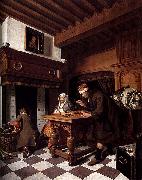 |
Cornelis de Man
|
|
(Delft, 1 July 1621 - Delft, 1 September 1706) was a Dutch Golden Age painter.
Kornelis was not satisfied with life in Delft. He wanted to travel beyond the port of Dordrecht and that is what he did, spending a year in Paris as soon as he came of age and had enough talent to pay his way with his painting skills. He was well-received, but set off in the Spring for Lyon in order to cross Lombardia and the mountains before another winter set in. He settled for two years in Florence, where he had a rich patron, but stayed the longest in Rome. On the way back home he stopped in Venice, and in the end was gone for a total of nine years |
|
|
|
|
|
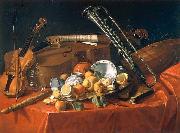 |
Cristoforo Munari
|
|
(July 21, 1667 - June 3, 1720) was an Italian painter of the late-Baroque specializing in still life paintings. He was also known as Cristofano Monari.
His initial training was in Reggio Emilia, his birthplace, and he came under the patronage of Rinaldo d'Este, Duke of Modena. In 1703-1706, he lived in Rome, then moved to Florence, where for about a decade he was attached to the court of the Medici. His still life paintings recall those of Evaristo Baschenis; however, the added disarray of porcelain, glass, and foodstuffs, suggest the hangover from the jovial surfeit of the Medici court. He painted also panoplies and war trophies. In 1715 he moved to Pisa where he worked almost exclusively in art restoration; he died in 1720.
An exhibition of his paintings took place in 1998 in Reggio Emilia, where it attracted wide attention and was a national success.
|
|
 |
Daniel Mijtens
|
|
(Delft, c. 1590 - The Hague, 1647/48), known in England as Daniel Mytens the Elder, was a Dutch portrait painter who spent the central years of his career working in England.
He was born in Delft into a family of artists and trained in The Hague, possibly in the studio of Van Mierevelt. He was the nephew of the painter Aert Mijtens, the older brother of the painter Isaac Mijtens, and the father of the painter Daniel Mijtens the Younger. No known work survives from his first Dutch period.
By 1618, he had moved to London where his initial patron was the leading art collector Thomas Howard, 21st Earl of Arundel. Mijtens painted the Earl and his Countess, and was soon commissioned to paint King James I and his son Charles, Prince of Wales. In 1625 he became painter to Charles I.
After the prince's accession to the throne as Charles I in 1625 Mijtens produced such a large number of full length portraits of Charles I and his courtiers, including duplicates, that it is assumed that he had workshop assistance. Two of his finest portraits are of the same man, James Hamilton later 1st Duke of Hamilton, whom he painted as a seventeen year old in 1623 and again in 1629. Mijtens made visits to the Netherlands in 1626 and 1630, perhaps to study the latest developments in his field, more particularly the works of Rubens and Van Dyck.
Mijtens introduced a new naturalism into the English court portrait, but after the arrival in England of the far more distinguished Anthony Van Dyck in 1632 he was superseded as the leading court portraitist, and around 1634 he appears to have returned to the Netherlands permanently. He subsequently worked primarily as an art dealer in The Hague, acquiring works for the Earl of Arundel among others. Only four paintings survive from this final period.
Some of Mijtens' works are still owned by the Royal Family. Mitjens also made copies of old portraits of royal sitters including; James IV of Scotland, his wife Margaret Tudor, and Mary, Queen of Scots.
|
|
|
|
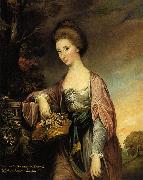 |
David Martin
|
|
painted Portrait of Elizabeth Rennie, Viscountess Melville in 1750-1847
|
|
|
|
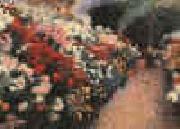 |
Dennis Miller Bunker
|
|
1861-1890
Dennis Miller Bunker Gallery
The paintings of Bunker's early maturity in New York (ca. 1880-82) were often marine subjects, featuring a series of beached boats, painted on Long Island. In these he followed the standard academic practice of first painting loose, preparatory sketches (Beached, ca. 1881-2) prior to more conventionally finished exhibition pieces. The early portraits (Portrait of Walter Griffin, 1881, Portland Museum of Art) also evidence rigorous craftsmanship.
While studying in Paris, Bunker's summer excursions to the countryside resulted in another series, this time of scenes of Larmor, a town in Brittany. The focus of these compositions, be it church spire (Brittany Town Morning, Larmor, 1884, Terra Foundation for American Art), cemetery cross, or a lone tree (Tree, 1884-5, private collection), was invariably that of a richly painted, dark graphic shape against a bright sky. Nevertheless, the pictures are characterized by soft atmospheric effects and tonal subtlety. No less subtle are the landscapes Bunker painted after returning to America; paintings done in South Woodstock, Connecticut (Pines Beyond the Fence, 1886, private collection) still favor dramatic value contrasts, with subjects carefully painted against a light sky, but the palette has grown lighter, the color more saturated.
By 1887 Bunker completed his Portrait of Anne Page, a painting requiring much labor, but one of his most poignant works. In its restrained use of color, delicate modeling of form, and aesthetic elegance it is reminiscent of the works of Thayer and James McNeill Whistler. There soon followed the Boston commissions, portraits mostly of male sitters--still somber in tone, they are painted in a more confident manner, suggesting the influence of Sargent (Portrait of George Augustus Gardner, 1888, Museum of Fine Arts, Boston).
Portrait Sketch of Eleanor Hardy Bunker, 1890. Private collection.That Bunker spent the summer of 1888 painting with Sargent is verified by personal correspondence, as well as through several pieces by the latter artist (Dennis Miller Bunker Painting at Calcot, 1888, Terra Foundation for American Art), but no paintings of the English sojourn by Bunker have survived; possibly he destroyed them in dissatisfaction. However, once back in Boston the experience came to fruition, for over the next two years Bunker produced a series of canvases which evidenced that he was one of the first American artists to fully understand and successfully practice impressionism. In the Greenhouse, ca. 1888, Chrysanthemums, 1888 (Isabella Stewart Gardner Museum), The Pool, Medfield, 1889 (Museum of Fine Arts, Boston), and Meadow Lands, 1890 (Museum of Fine Arts, Boston) all feature a rich palette, vertiginous compositions, and his unique "fish hook" shaped brush strokes.
At the same time, Bunker's last figure pieces remained faithful to his academic training. Jessica, 1890 (Museum of Fine Arts, Boston), The Mirror, 1890 (Terra Foundation for American Art), and Eleanor Hardy Bunker, 1890 (Metropolitan Museum of Art) are characterized by a restricted color range and heightened elegance. |
|
|
|
|
|
 |
Domenico Morelli
|
|
Italian, 1826-1901,Italian painter and teacher. Unique among his Italian colleagues in enjoying an international reputation in his lifetime, he was, with Filippo Palizzi (see PALIZZI, (2)), the leading exponent of the Neapolitan school of painting in the second half of the 19th century and a major figure in the artistic and cultural life of Italy. His realistic treatment of Romantic subjects revitalized academic painting, |
|
|
|
|
|
|
|
|
|
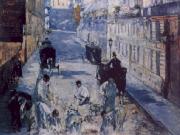 |
Edouard Manet
|
|
French Realist/Impressionist Painter, 1832-1883
The roughly painted style and photographic lighting in these works was seen as specifically modern, and as a challenge to the Renaissance works Manet copied or used as source material. His work is considered 'early modern', partially because of the black outlining of figures, which draws attention to the surface of the picture plane and the material quality of paint.
He became friends with the Impressionists Edgar Degas, Claude Monet, Pierre-Auguste Renoir, Alfred Sisley, Paul Cezanne, and Camille Pissarro, through another painter, Berthe Morisot, who was a member of the group and drew him into their activities. The grand niece of the painter Jean-Honor?? Fragonard, Morisot's paintings first had been accepted in the Salon de Paris in 1864 and she continued to show in the salon for ten years.
Manet became the friend and colleague of Berthe Morisot in 1868. She is credited with convincing Manet to attempt plein air painting, which she had been practicing since she had been introduced to it by another friend of hers, Camille Corot. They had a reciprocating relationship and Manet incorporated some of her techniques into his paintings. In 1874, she became his sister-in-law when she married his brother, Eugene.
Self-portrait with palette, 1879Unlike the core Impressionist group, Manet maintained that modern artists should seek to exhibit at the Paris Salon rather than abandon it in favor of independent exhibitions. Nevertheless, when Manet was excluded from the International exhibition of 1867, he set up his own exhibition. His mother worried that he would waste all his inheritance on this project, which was enormously expensive. While the exhibition earned poor reviews from the major critics, it also provided his first contacts with several future Impressionist painters, including Degas.
Although his own work influenced and anticipated the Impressionist style, he resisted involvement in Impressionist exhibitions, partly because he did not wish to be seen as the representative of a group identity, and partly because he preferred to exhibit at the Salon. Eva Gonzal??s was his only formal student.
He was influenced by the Impressionists, especially Monet and Morisot. Their influence is seen in Manet's use of lighter colors, but he retained his distinctive use of black, uncharacteristic of Impressionist painting. He painted many outdoor (plein air) pieces, but always returned to what he considered the serious work of the studio.
Manet enjoyed a close friendship with composer Emmanuel Chabrier, painting two portraits of him; the musician owned 14 of Manet's paintings and dedicated his Impromptu to Manet's wife.
Throughout his life, although resisted by art critics, Manet could number as his champions Emile Zola, who supported him publicly in the press, Stephane Mallarme, and Charles Baudelaire, who challenged him to depict life as it was. Manet, in turn, drew or painted each of them. |
|
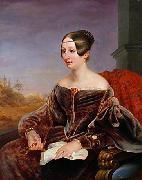 |
Eduard Magnus
|
|
(January 7, 1799 - August 8, 1872) was a German painter.
Magnus was born in Berlin, and studied simultaneously at the Berlin Academy of Art, Bauakademie, and University of Berlin. He later traveled to Paris and Italy, returning to Germany in 1829. He went to Italy again in 1831, and traveled through Paris and England before returning again in 1835. In 1837 he became a member of the Academy of Art, and in 1844 a professor. From 1850 to 1853 he traveled to France and Spain. He died in 1872 in Berlin. He was for a time the preeminent portrait painter in Berlin.
Eduard Magnus was the elder brother of the physicist and chemist Heinrich Gustav Magnus.
|
|
|
|
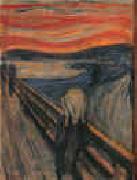 |
Edvard Munch
|
|
Norwegian
1863-1944
Edvard Munch Locations
Edvard Munch (pronounced , December 12, 1863 ?C January 23, 1944) was a Norwegian Symbolist painter, printmaker, and an important forerunner of expressionistic art. His best-known composition, The Scream is one of the pieces in a series titled The Frieze of Life, in which Munch explored the themes of life, love, fear, death, and melancholy.
Edvard Munch was born in a rustic farmhouse in the village of Adalsbruk in Loten, Norway to Christian Munch, the son of a prominent priest. Christian was a doctor and medical officer, who married Laura Cathrine Bjølstad, a woman half his age, in 1861. Edvard had an older sister, Johanne Sophie (born 1862), and three younger siblings: Peter Andreas (born 1865), Laura Cathrine (born 1867), and Inger Marie (born 1868). Both Sophie and Edvard appear to have gotten their art talent from their mother. Edvard Munch was related to painter Jacob Munch (1776?C1839) and historian Peter Andreas Munch (1810?C1863).
The family moved to Kristiania (now Oslo) in 1864 when Christian Munch was appointed medical officer at Akershus Fortress. Edvard??s mother died of tuberculosis in 1868, as did Munch's favorite sister Johanne Sophie in 1877. After their mother's death, the Munch siblings were raised by their father and by their aunt Karen. Often ill for much of the winters and kept out of school, Edvard would draw to keep himself occupied. He also received tutoring from his school mates and his aunt. Christian Munch also instructed his son in history and literature, and entertained the children with vivid ghost stories and tales of Edgar Allan Poe.
Christian??s positive behavior toward his children, however, was overshadowed by his morbid pietism. Munch wrote, ??My father was temperamentally nervous and obsessively religious??to the point of psychoneurosis. From him I inherited the seeds of madness. The angles of fear, sorrow, and death stood by my side since the day I was born.?? Christian reprimanded his children by telling them that their mother was looking down from heaven and grieving over their misbehavior. The oppressive religious milieu, plus Edvard??s poor health and the vivid ghost stories, helped inspire macabre visions and nightmares in Edvard, who felt death constantly advancing on him. One of Munch's younger sisters was diagnosed with mental illness at an early age. Of the five siblings only Andreas married, but he died a few months after the wedding. Munch would later write, "I inherited two of mankind's most frightful enemies??the heritage of consumption and insanity."
Christian Munch??s military pay was very low, and his attempts at developing a private side practice failed, keeping his family in perrenial poverty. They moved frequently from one sordid flat to another. Munch??s early drawings and watercolors depicted these interiors, and the individual objects such as medicine bottles and drawing implements, plus some landscapes. By his teens, art dominated Munch??s interests. At thirteen, Munch has his first exposure to other artists at the newly formed Art Association, were he admired the work of the Norwegian landscape school, and where he returned to copy the paintings, and soon he began to paint in oils. |
|
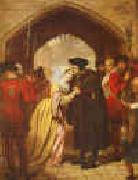 |
Edward Matthew Ward
|
|
British Painter.
1816-1879
His parents encouraged his early interest in art. He was sent to a number of art schools, including that of John Cawse (1779-1862), before gaining entry to the Royal Academy Schools in 1835. He first exhibited at the Royal Academy in 1834 with Adelphi Smith as Don Quixote (untraced). In 1836 he went abroad for further study, visiting Paris and Venice on the way to Rome, where he spent three years. His first work of any consequence was Cimabue and Giotto (untraced), which he sent back to the Royal Academy show of 1839. On the way back to England at the end of that year Ward visited Munich to learn the technique of modern fresco painting in order to take part in the competition to decorate the Palace of Westminster, but his cartoon, Boadicea (1843; untraced), was unsuccessful. However, in 1852 he was commissioned to produce eight pictures for the Palace of Westminster, on subjects drawn from the English Civil War, the best of which is the Last Sleep of Argyll (1860s) in the Commons Corridor of the Houses of Parliament
|
|
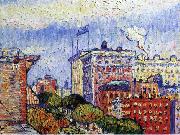 |
Edward Middleton Manigault
|
|
(June 14, 1887 - August 31, 1922) was an American Modernist painter.
Manigault was born in London, Ontario on June 14, 1887. His parents were Americans originally from South Carolina.Encouraged in art from an early age, he was commissioned at the age of 18 the city of London to make renderings of public buildings for reproduction as postcards. |
|
|
|
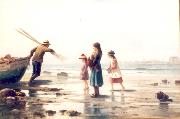 |
Edward Moran
|
|
(August 19, 1829 in Bolton, Lancashire, England -June 8, 1901 in New York City) was an American artist.
He emigrated with his family to America at the age of 15, and subsequently settled in Philadelphia, where after having followed his fathers trade of weaver, he became a pupil of James Hamilton and Paul Weber. In 1862 he became a pupil of the Royal Academy in London; he established a studio in New York in 1872, and for many years after 1877 lived in Paris. He was a painter of marine subjects and examples of his work such as Devile Crag; Island of Grand Manan are in many prominent collections. Among his canvases are 13 historical paintings, intended to illustrate the marine history of America from the time of Leif Ericsson to the return of Admiral Dewey's fleet from the Philippines in 1899.
His sons Edward Percy Moran (born 1862) and Leon Moran (born 1864), and his brothers Peter Moran (born 1842) and Thomas Moran. |
|
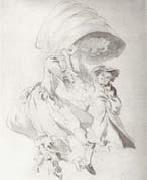 |
Elias Martin
|
|
Swedish Painter, 1739-1818,Painter and engraver. After training in his father joinery shop and with the painter Friedrich Schultz (1709-69), he was engaged to design ornamentation for ships of the coastal fleet at Sveaborg (Finland). There he also taught drawing to the son of Field Marshal Count Augustin Ehrensv?rd (1710-72) while himself learning printmaking techniques from the Field Marshal. During this period Martin produced accurate studies of Finland coastal scenery and the Sveaborg fortress (e.g. Stockholm, Nmus.), as well as purely imaginary landscapes based on engravings. In 1766 he went to Paris and with Alexander Roslin help was able to study under Joseph Vernet at the Acad?mie Royale de Peinture et de Sculpture. A direct result of his studies was a View of Paris from the Quay Beneath the Pont Neuf (1766-7; Stockholm, Nmus.). |
|
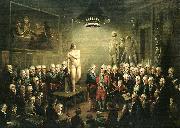 |
elias martin, gustav
|
|
Elias Martin, döpt 8 mars 1739 i Stockholm, död 25 januari 1818, svensk målare som vann internationell berömmelse under sin livstid för sina landskapsmålningar, porträtt och genremålningar, och var "associate member" av Royal Academy.
Elias Martin var son till åldermannen i snickarämbetet Olof Martin och Ulrika Haupt, syster till Georg Haupt. Han fick sin första utbildning hos fadern och visade sådan talang att han sändes till ämbetsmålaren F.C. Schultz. Genom denne fick han anställning hos Fredrik Henrik af Chapman som arkitekturritare och teckningslärare för officerarna i Sveaborg. Där fick han ledning av fältmarskalken Augustin Ehrensvärd, och umgick med och undervisade dennes son Carl August Ehrensvärd. |
|
|
|
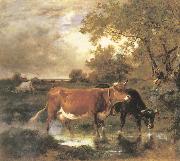 |
Emile Van Marcke de Lummen
|
|
1827-1890
Emile van Marcke was born in S??vres - into a family of artists. His father was Jean-Baptiste (1797-1848), the eldest son of Charles van Marcke and a painter who specialized not only in landscape and animal paintings, but also works on porcelain. |
|
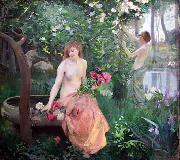 |
emile-Rene Menard
|
|
(1861 - 1930) was a French painter born in Paris. From early childhood he was immersed in an artistic environment: Corot, Millet and the Barbizon painters frequented his family home, familiarizing him thus with both landscape and antique subjects.
Menard studied at the Academy Jullian from 1880 after having been a student of Baudry, Bouguereau, and Henri Lehmann. He participated in the Salon of the Secession in Munich, and the Salon de la Libre Esthetique in Brussels during 1897. Several personal exhibitions were also devoted to him at the Georges Small Gallery. In 1921 he exhibited in the Twelfth Salon along with Henri Martin and Edmond Aman-Jean. Galleries in Buffalo, New York and Boston, Massachusetts exposed Menard and his art to the United States. However, the numerous commissions that Menard received from the French government crowned his career; for example, the cycle for the Hautes Etudes e la Sorbonne, the Faculte de Droit, and the fresco Atoms for the Chemistry institute, and finally the Caise des Depôts in Marseilles.
Menard's art allies a rigorous, clear classicism with a diffuse and dreamlike brushwork. In 1894, Victor Shoe wrote of Menard in l' Art et la Vie (Art and Life): "visions of a pacified, bathed nature, of dawn and of twilight, where the soul seems to immerse itself in the innocence of daybreak, and breathe the divine anointment that comes with the dawn."
|
|
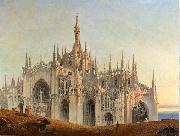 |
Emilio Magistretti
|
|
(Milan, 1851 - 1936) was an Italian painter.
Magistretti studied at the Brera Academy of Fine Arts from 1871 to 1875 under the guidance of Francesco Hayez and then accompanied him on his Italian journey of 1879. He worked initially in a range of different areas, from genre scenes to religious subjects and perspective painting, and successfully tried his hand at painting portraits, animals and landscapes at the turn of the century. He began to establish his reputation as an artist in 1880, when he was awarded a prize by the Ministry of Education, and became well known as a painter of moderately naturalistic portraits particularly appreciated by the middle-class establishment. An autobiography richly illustrated with reproductions of his most celebrated works was published in 1926.
|
|
|
|
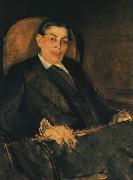 |
Eouard Manet
|
|
He was a French painter. One of the first 19th-century artists to approach modern and postmodern-life subjects, he was a pivotal figure in the transition from Realism to Impressionism.
His early masterworks, The Luncheon on the Grass (Le dejeuner sur l'herbe) and Olympia, engendered great controversy and served as rallying points for the young painters who would create Impressionism. Today, these are considered watershed paintings that mark the genesis of modern art. |
|
|

